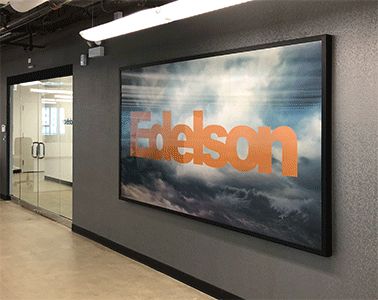Animate your audience
Part of making a great lenticular print is selecting the right materials and processes along the way. Evolving technologies and availability of materials are big factors in these decisions, and most of these concerns are handled behind the scenes. But for those that want a better sense of what options may exist or to understand the the mechanics more fully here are a few of the things that make up the lenticular toolkit.
Types of Materials
Lenticular plastic sheets, commonly referred to simply as “lens,” come in three basic material types, PETG, Acrylic and Polystyrene. The majority of lenticular lens used in the United States and Europe is PETG, a form of polyester which is very durable and long lasting. It is resistant to impact fractures and cracking and is a great choice for both fine art and commercial lenticular.
Acrylic (PMMA) is a very common everyday sheet plastic and some very high quality lenticular lenses have been made from acrylic resin. Acrylic is known for its clarity, especially when used in thicker sheet products, and can be used outside.
Polystyrene, or PS, is also a clear plastic resin suitable for thick sheet products, and is the least expensive of the plastics used to make lenticular. Unfortunately PS is very brittle and yellows quickly with exposure to UV, and is generally not considered a durable material for lenticular production.
LPI
Perhaps the best known feature of a lenticular lens is its resolution which is measured in ‘lenticules’ per inch or LPI. The LPI of a lens can be very coarse or fine which is an indication of its intended viewing distance. Large format lenticular typically uses lenses in the 15 LPI - 40 LPI range. LPI represents one of the first tradeoffs that are considered when making a lenticular print. Coarser lenses hide neighboring images better to lessen “ghosting” between frames and offer greater viewing distances with more precision. Finer lenses excel because their surface structure can completely disappear when viewed from several feet, making them a good choice when there is a lot of fine detail. But there are no strict rules with LPI, large pieces are often very effectively printed on fine lenses - it depends on how the artwork is set up and the expectations of the designer.
Thickness
For large format lenticular thickness is a range that goes from .033” to .15” and is typically affected by two factors, the LPI and whether the lens is meant for 3D or motion. 3D lenses are always thicker than motion lenses and lower LPI lenses are often thicker than higher LPI lenses. In many cases the thickness is not important to the end user unless the print must fit into an existing fixture that has certain tolerances. As a general rule large format lenticulars require a display support of some kind to prevent sagging.
Viewing Angle
Lenticular sheets are engineered with a particular viewing angle with typical ranges from 25 to 54 degrees. Lenses with narrow viewing angles are usually meant for 3D and wider for motion, but both effects can be achieved with lenses of any viewing angle with varied results. The most apparent result of the viewing angle is how quickly the lenticular flips, with narrow viewing angles producing quick flipping imagery and a wider angle producing slower flips. The viewing angle also determines how many times the image sequence will repeat, for example a 3 image sequence will repeat 4 times using a 45 degree lens but 7 times using a 25 degree lens.
Viewing Distance
Lenticular lens has limits in terms of how effective it is at various distances. In general the same considerations given to LPI apply here, with fine LPI lenses having shorter viewing distances (1-10 ft) and coarser lenses being more suitable for distance viewing (5-30 ft). The effectiveness of a lenticular print beyond 30 ft is variable and the amount of movement required to engage the effect can become a deterrent to lenticulars with exceptionally long viewing distances.
Printing Processes
For large format lenticular there are multiple methods of production that can yield good results. A majority of lenticular printing is done using commercial inkjet printers and the results are mounted to the lenticular plastics in a two step process. Lenticular prints made this way can be very high quality and this is often the choice when creating fine art lenticular work. Another method using UV cured inks prints directly to the lenticular sheet, which has some advantages for outdoor displays. This technology has made a lot of progress and is capable of producing very high quality lenticular prints. Lambda and Lightjet printers also have a history of making beautiful lenticular prints but their reliance on photographic chemistry has made them less common in the current environment.




